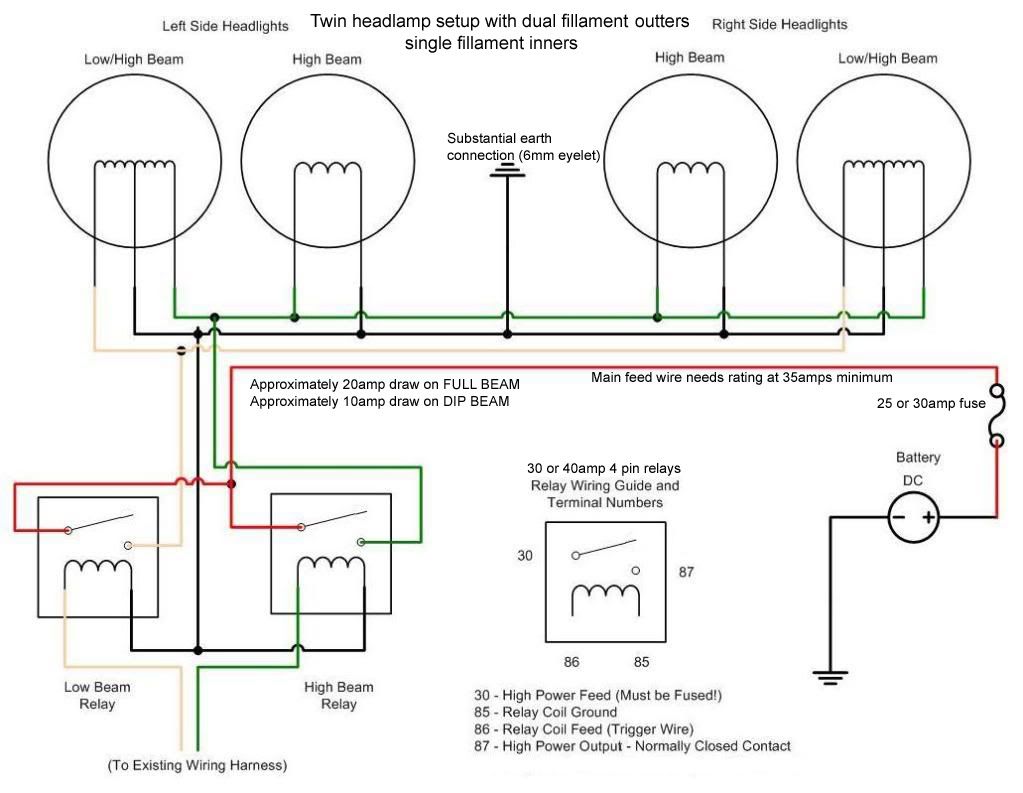Phil Lander in Australia, outlined a headlamp bulb and electrical circuit upgrade, for the 1980~92 VW Transporter (i.e. Type 25, T3 or Vanagon) - specifically his own VW Syncro, published by the Volkswagen Type 2 Owners' Club in 1996, 1998 & 2007, as follows:
Phil Lander, "Headlight Upgrade", High Beams From Low Altitudes or Headlight Hints From Down Under!, Transporter Talk, Issue 26, December 1996, Pages 24~25.
Phil Lander, "Uprating Headlamps", Technical Information Sheet: Topic 8, VW Type 2 Owners' Club, 1998.
Phil Lander, "Uprating Headlamps", Transporter Talk, Issue 90, August 2007, Pages 38~39.
In late 1980s, concerned about the legality of retro-fitting high-power, H4 quartz-halogen bulbs, to my 1973 VW "1600" Type 2 campervan, I made enquiries to the RAC Legal Department, the Department of Transport and the Essex Traffic-Police Headquarters (I had two acquaintances there, who taught motoring law), who variously referred me to the relevant Statutory Instruments.
The general consensus, was that vehicles first used before 1st April 1986, which were not required to have E-marked headlamp units, could legally use replacement bulbs lacking E-marks, including high-power, H4 quartz-halogen bulbs, such as the P45t flanged, 100/80W H4 bulbs, which I retro-fitted to my non-H4 headlamps, in circa 1988/89.
Although it is technically possible, to upgrade any vehicle with high-power headlamps, the legality of doing so, varies according to country, plus the date on which the vehicle was manufactured or first registered. For example, in the United Kingdom, vehicles first used before 1st April 1986 (i.e. all 1950~67 & 1968~79 VW Type 2s, plus about half the 1980~92 VW Type 25s), are subject to a minimum power of 30W per lamp, on both main & dipped beams and the universal requirement that the headlamps should not cause undue dazzle to other road users. Surprisingly, no maximum power is specified!
The Road Vehicles Lighting Regulations 1989, Statutory Instrument 1989, No. 1796.
http://www.opsi.gov.uk/si/si1989/Uksi_19891796_en_1.htm
In contrast, vehicles first used on or after 1st April 1986 (i.e. about half the 1980~92 VW Type 25s - aka T3 or Vanagon), are subject to no explicit minimum or maximum power, but both the headlamp units and the bulbs fitted to them, must bear an appropriate E-mark, showing ECE-standard compliance, which might implicitly restrict the power ratings or light intensity, that may legally be employed, dependent upon the bulbs available.
The Filament Lamps for Vehicles (Safety) Regulations 1982, Statutory Instrument 1982, No. 444.
However, the modern Xenon enhanced, 60/55W quartz-halogen bulbs, for which upto 100% greater light intensity is claimed, are said to comply with these standards. Of course, clean, properly aligned headlamps, cause minimal dazzle, so it's probably unlikely that any law officers or MOT inspectors, would seek to inspect the markings on one's headlamp bulbs!
When purchasing replacement H4 quartz-halogen bulbs, it is important to obtain those with the correct flange type, whether P45t or P43t, as illustrated.
Two-dimensional projections of P45t & P43t flanged bulbs
 P45t flanged, conventional glass-enveloped bulb
P45t flanged, conventional glass-enveloped bulb
 P45t flanged, substitute-H4 quartz-halogen bulb
P45t flanged, substitute-H4 quartz-halogen bulb
 P43t flanged, dedicated-H4 quartz-halogen bulb
P43t flanged, dedicated-H4 quartz-halogen bulb

Alternatively, there is a bulb-installation adapter (Part No. BP4543AD), which facilitates fitting a P43t flanged, quartz-halogen H4 bulb into a headlamp unit with P45t flange recepticle, available from P. R. Goff, in Buckinghamshire.
http://www.norbsa02.freeuk.com/goffybulbs.htm
P. R. Goff, 62 Clare Road, Prestwood, Buckinghamshire, HP16 0NU, United Kingdom.
Tel. (UK) 01494 - 868 218 Tel. (International) +44 1494 - 868 218
Website:
http://www.norbsa02.freeuk.com E-mail:
norbsa02@aol.com
P43t flange to P45t flange-recepticle adaptor (on its own)
 P43t flange to P45t flange-recepticle adaptor (with bulb, in headlamp unit)
P43t flange to P45t flange-recepticle adaptor (with bulb, in headlamp unit)







